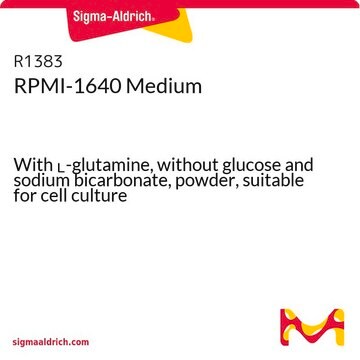D5030
Dulbecco′s Modified Eagle′s Medium
Without glucose, L-glutamine, phenol red, sodium pyruvate and sodium bicarbonate, powder, suitable for cell culture
Synonyme(s) :
DME, DMEM
About This Item
Produits recommandés
Niveau de qualité
Forme
powder
Technique(s)
cell culture | mammalian: suitable
Composants
phenol red: no
NaHCO3: no
L-glutamine: no
HEPES: no
glucose: no
sodium pyruvate: no
Conditions d'expédition
ambient
Température de stockage
2-8°C
Description générale
Application
- to culture the isolated flexor digitorum brevis (FDB) fibers to measure exogenous fatty acid (FA) utilization as part of oxygen consumption rate (OCR) measurements
- to culture the isolated tibialis anterior (TA) muscle fibers for lactate measurements
- to culture the human bone marrow mesenchymal stem cells for osteogenic differentiation to prepare a low-glucose medium to culture human hepatocellular carcinoma HepG2 cells
Quantité
Reconstitution
Produit(s) apparenté(s)
Souvent commandé avec ce produit
Supplément
Mention d'avertissement
Warning
Mentions de danger
Conseils de prudence
Classification des risques
Eye Irrit. 2
Code de la classe de stockage
11 - Combustible Solids
Classe de danger pour l'eau (WGK)
WGK 3
Point d'éclair (°F)
Not applicable
Point d'éclair (°C)
Not applicable
Certificats d'analyse (COA)
Recherchez un Certificats d'analyse (COA) en saisissant le numéro de lot du produit. Les numéros de lot figurent sur l'étiquette du produit après les mots "Lot" ou "Batch".
Déjà en possession de ce produit ?
Retrouvez la documentation relative aux produits que vous avez récemment achetés dans la Bibliothèque de documents.
Les clients ont également consulté
Notre équipe de scientifiques dispose d'une expérience dans tous les secteurs de la recherche, notamment en sciences de la vie, science des matériaux, synthèse chimique, chromatographie, analyse et dans de nombreux autres domaines..
Contacter notre Service technique







